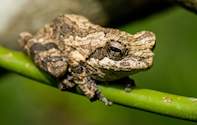
The grey tree frog - more commonly referred to as the foam nest frog - is the largest of our 'tree frogs', with females growing to a length of around 100 mm. The genus Chiromantis contains only three known species confined to the tropical and sub-tropical regions of Africa. The foam nest frog - Chiromantis xerampelina - is the only species in South Africa and is confined to the northern bushveld, eastern lowveld and south through Swaziland and northern KwaZulu-Natal to the coast. Its range extends from this area into northern territories.
These frogs are well adapted to a dry, arboreal life although they may frequently visit water to rehydrate. They will rarely be found swimming or sitting in water like many other frogs and toads but are commonly found in and around buildings where lights attract a source of insect food. With a variety of mottled patterns, they can change colour within a range of white to dark grey to match their background and are well camouflaged against tree bark. Females grow much larger and can be double the weight of males.
Foam Nests
The common name comes from the whitish clumps of foam that they construct as 'nests' in which to lay their eggs. These nests are always constructed on some branch or object over, and often many metres above, water. The females exude a sticky liquid which they kick into a froth with their back legs. Into this foam they lay up to 1000 eggs which are fertilised by, often many, attendant males. The foam prevents desiccation of the eggs and keeping eggs and small tadpoles out of water eliminates much predation.
About five days after hatching the small tadpoles wriggle out of the foam to drop into the water below, where they continue to grow and complete their normal metamorphosis.High foam nests can be a useful water indicator in the bush although temporary pools often dry up prematurely, destroying many breeding attempts.
Aestivation
Animals 'hibernate', in a state of torpor, during periods of extreme cold. In hot, dry conditions, like we experience in the sub-tropics, animals 'aestivate' in the same manner. To survive through harsh conditions without food, metabolism is lowered and adaptations made to reduce loss of moisture.
In successful individuals of Chiromantis they will be hydrated and well fed before aestivation over the many dry months of our 'winter'. This means that fortunate frogs will have accumulated sufficient body fat and moisture to carry them through. To cut down moisture loss they choose a suitable resting spot and tuck in their long legs to reduce the surface area of exposed skin. Where parts of the legs contact the body the 'joins' are sealed with a mucous to minimise evaporation.
Normal breathing is almost stopped and they basically breathe through their porous skin. In extreme heat they are compelled to sweat to cool down. They conserve moisture by excreting nitrogen in the form of uric acid with very little water loss. Although these adaptations allow the frogs to survive for many dry months in exposed positions, it is a precarious period during which they cannot sustain any disturbance.
Survival
These and all frogs are extremely beneficial in limiting insect numbers. They will often be found in human dwellings. They are completely harmless to humans and domestic animals (apart from skin secretions to stop dogs biting them!). They often take up positions in crevices of open windows and door frames before the onset of cold weather. Being creatures of habit they have select spots in cupboards, pelmets etc, to which they will return. They are fascinating and useful creatures which make very little mess.
My plea to readers is that they do not disturb these frogs when they are in the precarious, aestivating state. If it is imperative that you move them, then do so before they settle down to give them a chance to survive the dry months. Frogs are some of the most environmentally sensitive creatures on earth. They have particularly sensitive skins so do not use any insecticide sprays anywhere near these frogs. If you disturb an aestivating frog it will expose its sealed and protected parts causing extreme and irreplaceable moisture loss. In addition, most reptiles often eject a stream of liquid as a defence when threatened, resulting in further, unaffordable loss of vital fluid which could threaten their survival. (The same applies to tortoises that are handled).
Check all window and door frames before closing windows and doors. Prevent anyone from poking or otherwise disturbing any immobile frogs. Any disturbance will sentence the frog to a slow death and add one more nail in the coffin of environmental quality. The joy of hearing that cheerful, quacking chirp that heralds the rain will be gone from our area. To learn more, obtain one of the several available books on frogs with further information on these fascinating and useful creatures.
Read more interesting articles about frogs

